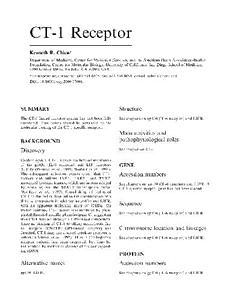
CT-1 Receptor PDF
Preview CT-1 Receptor
CT-1 Receptor Kenneth R. Chien* Department of Medicine, Center for Molecular Genetics, and the American Heart Association-Bugher Foundation, Center for Molecular Biology, University of California, San Diego School of Medicine, 9500 Gilman Drive, La Jolla, CA 92093, USA *corresponding author tel: 619 534 6835, fax: 619 534 8081, e-mail: [email protected] DOI: 10.1006/rwcy.2000.17006. SUMMARY Structure The CT-1 ligand receptor system has not been fully See chapters on gp130 (IL-6 receptor) and LIFR. elucidated. This notion should be advanced by the molecular cloning of the CT-1-specific receptor. Main activities and pathophysiological roles BACKGROUND Discovery See chapter on CT-1. Cardiotropin 1, CT-1, signals via heterodimerization of the gp130 (IL-6 receptor) and LIF receptors GENE (LIFR) (Pennica et al., 1995; Wollert et al., 1996). The subsequent activation events reveal that CT-1 Accession numbers induces and utilizes JAK1-, JAK2-, and TYK2- associated tyrosine kinases, which are in turn relayed See chapters on gp130 (IL-6 receptor) and LIFR. A by signaling via the STAT3 transcription factor CT-1-specific receptor gene has not been cloned. (Robledo et al., 1997). Crosslinking of iodinated CT-1 to the cell surface led to the identification of a third (cid:11) component in addition to gp130 and LIFR, Sequence with an apparent molecular mass of 80kDa. On motor neurons, CT-1 action was inhibited by phos- See chapters on gp130 (IL-6 receptor) and LIFR. phatidylinositol-specific phospholipase C, suggesting that CT-1 may act through a GPI-linked component. Since no binding of CT-1 to ciliary neurotropic fac- Chromosome location and linkages tor receptor (CNTFR; GPI-linked receptor) was detected, CT-1 may use a novel cytokine receptor (cid:11) subunit (Pennica et al., 1996). Thus, a CT-1-specific See chapters on gp130 (IL-6 receptor) and LIFR. receptor subunit has been proposed, but thus far not verified by molecular cloning of the correspond- ing cDNA. PROTEIN Alternative names Accession numbers gp130, LIFR. See chapters on gp130 (IL-6 receptor) and LIFR. 1814 Kenneth R. Chien Description of protein Release of soluble receptors See chapters on gp130 (IL-6 receptor) and LIFR. See chapters on gp130 (IL-6 receptor) and LIFR. Crosslinking of iodinated CT-1 to the cell surface led to the identification of a third component in addition to gp130 and LIFR, with an apparent SIGNAL TRANSDUCTION molecular mass of 80kDa. Removal of N-linked carbohydratesfromtheproteinbackboneofthethird Associated or intrinsic kinases componentresultedinaproteinof45kDa.Onmotor neurons, CT-1 action was inhibited by phosphatidy- CT-1 induces the rapid tyrosine phosphorylation of linositol-specific phospholipase C, suggesting that gp130 and LIFR, leading to the activation of JAK1, CT-1 may act through a GPI-linked component JAK2, and TYK2 kinase, as reported for the other (Pennicaetal.,1996)(seechapteronCNTFreceptor). members of the IL-6 cytokine family (Wollert et al., 1996; Robledo et al., 1997). Relevant homologies and species Cytoplasmic signaling cascades differences See section on In vitro activities in the chapter See chapters on gp130 (IL-6 receptor) and LIFR. on CT-1. Affinity for ligand(s) DOWNSTREAM GENE ACTIVATION Bindingstudiesemployingpurifiedsolublegp130and LIFR molecules demonstrate that CT-1 binds to the Transcription factors activated LIFRwithaboutthesameaffinityasLIFbutfailsto bind to gp130 alone; however, the addition of gp130 See section on In vitro activities in the chapter enhanced the binding of CT-1 to the LIFR (Pennica on CT-1. et al., 1995). Therefore CT-1 receptor binding invol- ves an initial low-affinity interaction with the LIFR, followed by the recruitment of gp130 into a high- Genes induced affinity heterotrimeric complex (Pennica et al., 1995). See section on In vitro activities in the chapter on CT-1. Cell types and tissues expressing the receptor Promoter regions involved See the chapters on gp130 (IL-6 receptor) and LIFR. See the chapters on gp130 (IL-6 receptor) and LIFR. Functional studies and receptor-binding studies in cultured cardiomyocytes and the mouse myeloid leukemiacell line M1have revealedthat CT-1 signals BIOLOGICAL CONSEQUENCES through the gp130/LIFR heterodimer in cardiomyo- cytes, most likely without a further requirement for a OF ACTIVATING OR INHIBITING specific receptor (Pennica et al., 1995, 1996; Wollert RECEPTOR AND et al., 1996). By contrast, CT-1 signaling in neuronal PATHOPHYSIOLOGY cellsmayrequireanadditionalCT-1-specificreceptor (Pennica et al., 1996; Robledo et al., 1997). Unique biological effects of activating the receptors Regulation of receptor expression SeesectiononInvivobiologicalactivitiesofligandsin See chapters on gp130 (IL-6 receptor) and LIFR. animal models in the chapter on CT-1. CT-1 Receptor 1815 References Signalingofthecardiotrophin-1receptor.Evidenceforathird receptorcomponent.J.Biol.Chem.272,4855–4863. Wollert,K.C.,Taga,T.,Saito,M.,Narazaki,M.,Kishimoto,T., Pennica, D., Shaw, K. J., Swanson, T. A., Moore, M. W., Glembotski,C.C.,Vernallis,A.B.,Heath,J.K.,Pennica,D., Shelton, D. L., Zioncheck, K. A., Rosenthal, A., Taga, T., Wood, W. I., and Chien, K. R. (1996). Cardiotrophin-1 acti- Paoni, N. F., and Wood, W. I. (1995). Cardiotrophin-1. vates a distinct form of cardiac muscle cell hypertrophy. Biologicalactivitiesandbindingtotheleukemiainhibitoryfac- Assembly of sarcomeric units in series VIA gp130/leukemia tor receptor/gp130 signaling complex. J. Biol. Chem. 270, inhibitory factor receptor-dependent pathways. J. Biol. Chem. 10915–10922. 271,9535–9545. Pennica,D.,Arce,V.,Swanson,T.A.,Vejsada,R.,Pollock,R.A., Armanini, M., Dudley, K., Phillips, H. S., Rosenthal, A., Kato, A. C., and Henderson, C. E. (1996). Cardiotrophin-1, a LICENSED PRODUCTS cytokinepresentinembryonicmuscle, supportslong-termsur- vivalofspinalmotoneurons.Neuron17,63–74. See the chapters on gp130 (IL-6 Receptor) and LIF Robledo,O.,Fourcin,M.,Chevalier,S.,Guillet,C.,Auguste,P., Pouplard-Barthelaix, A., Pennica, D., and Gascan, H. (1997). Receptor.
